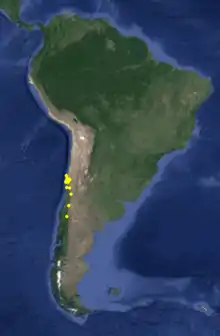Tristerix aphyllus
Tristerix aphyllus is a holoparasitic plant species of the genus Tristerix [1] in the family Loranthaceae. It is endemic to Chile. T. aphyllus is sometimes called the "cactus mistletoe." It should not be confused with the mistletoe cactus, which is an epiphytic cactus, and not a mistletoe.
| Tristerix aphyllus | |
|---|---|
 | |
| Tristerix aphyllus | |
| Scientific classification | |
| Kingdom: | Plantae |
| Clade: | Tracheophytes |
| Clade: | Angiosperms |
| Clade: | Eudicots |
| Order: | Santalales |
| Family: | Loranthaceae |
| Genus: | Tristerix |
| Species: | T. aphyllus |
| Binomial name | |
| Tristerix aphyllus Tiegh. ex Barlow & Wiens [2] | |
 | |
| Occurrence data from GBIF | |
Description
The mistletoe, Tristerix aphyllus, parasitizes two species of cactus, Echinopsis chiloensis and Eulychnia acida, and in its adult form shows only its flowers and its fruits, bursting forth spectacularly from the columnar cacti which are its hosts.[3] Mauseth (2011) discusses the morphological/anatomical effects of T. aphyllus on the cactus Echinopsis chiloensis.[4]
Taxonomy
T. aphyllus was first described by John Miers in 1830 as Loranthus aphyllus[5] but with the publication in 1973 of an article by Barlow & Wiens,[6] became Tristerix aphyllus (author, Tieghem (Tiegh.)).
Other synonyms are:
- Loranthus cactorum Hook. & Arn. Bot. Beechey Voy. 25. 1830 [Dec 1830]
- Loranthus pumilus Miers ex Schult. & Schult.f. Syst. Veg., ed. 15 bis [Roemer & Schultes] 7(2): 1649. 1830 [Oct-Dec 1830]
- Phrygilanthus aphyllus (Miers ex DC.) Eichler Fl. Bras. (Martius) 5(2): 47. 1868 [15 Jul 1868]
(sourcesː Govaerts et.al.,[7] International Plant Names Index, 2018)

References
- Kraus, R., P. Trimborn, and H. Ziegler. 1995. Tristerix aphyllus, a holoparasitic Loranthaceae. Naturwissenschaften 82: 150-151.
- International Plant Names Index. 2018. "Tristerix aphyllus". Published online. Accessed 4 April 2018.
- Nickrent, D.L.. et al. 2018. "Parasitic Plant Connection: Tristerix aphyllus". Accessed: 4 April 2018.
- Mauseth, J.D., Montenegro, G.M. Walckowiak, A.M. 2011. Studies of the holoparasite Tristerix aphyllus (Loranthaceae) infecting Trichocereus chilensis (Cactaceae). Canadian Journal of Botany 62(4):847-857 doi:10.1139/b84-124 "(pdf)".
- Miers, J. 1830 in Prodromus (ed de Candolle 4:307.
- Barlow, B.A. & Wiens, D. 1973. The classification of the generic segregates of Phrygilanthus (= Notanthera) of the Loranthaceae. Brittonia 25, 26. doi:10.2307/2805488 (p.39̟)
- Govaerts, R. et al. 2018. "Tristerix aphyllus". in Kew Science Plants of the World online. The Board of Trustees of the Royal Botanic Gardens, Kew. Published online. Accessed: 4 April 2018.
External links
- Images of Tristerix aphyllus at PhytoImages, Southern Illinois University. Accessed 4 April 2018.